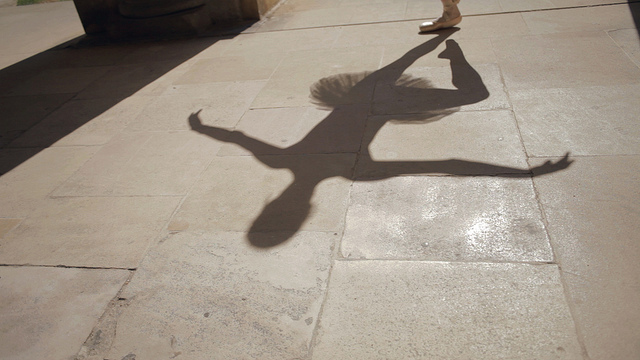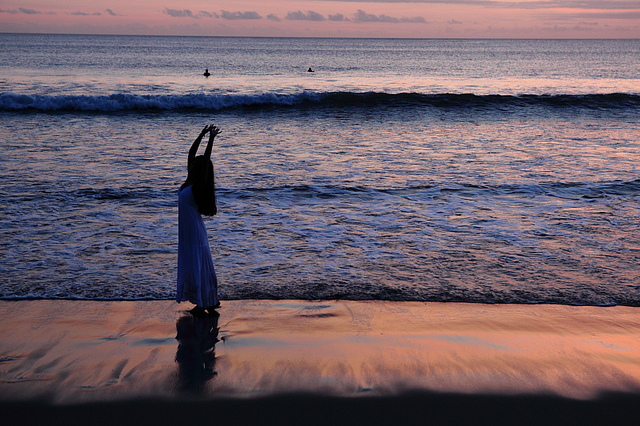
Punting Cambridge. Licensed under CC Attribution-ShareAlike 2.0 Generic.
The concept of “Body Image” is both challenging and crucial to dancers. As dancers, our bodies are our instruments. We sculpt our bodies through our training to perform at their best, and we are constantly assessing ourselves in order to perfect our craft. Body Image becomes challenging for dancers since, when looking at one’s body so closely, it seems far easier to scrutinize and berate our “flaws” than it is to acknowledge and praise our beauties. Cultivating a positive body image, where one can assess and critique their body, without berating it, is crucial for success as a dancer.
“Body Image” refers to how you “see” your body – both literally as you see the reflection of your body in a mirror, and as you see your body represented in your mind’s eye. Generally speaking, there are two types of body image – positive and negative. Someone with a positive body image feels content in and about their body, exactly how it is, while some one with a more negative body image tends to feel unhappy with, and uncomfortable in, their body. For most people, their body image lies somewhere in the middle, oscillating between the two, depending upon their current circumstances. That being said, if you find yourself experiencing drastically greater instances of negative thoughts and feelings about your body than neutral or positive thoughts about your body, you may well have a negative body image.
The interesting thing about a negative body image is that you can’t exactly just get rid of it (much as we would like to) or even necessarily “heal” it. All you can do is try to cultivate a better one. And, slowly, through a committed practice, you can shift your tendencies towards negative thoughts and feelings about your body to more positive ones.
With that in mind, here are 5 Simple Strategies, that you can start doing right now, to help improve your body image:
1. Go on a “negative-thought” diet.
Since body image is a result of how we see, feel and think about our bodies, changing our thinking and self-talk from negative to positive is essential for cultivating a more positive body image. The first step is to simply start observing your thoughts. Notice what you think and say to yourself about your body.
If you find yourself having unwanted negative thoughts, the next step is to rationally challenge them. Ask yourself, “Is this negative thought about myself reasonable?” Chances are the answer is no. Once you’ve determined this, try replacing the negative thought with a more positive thought or affirmation. Positive affirmations are shown to be most beneficial when they are specific, expressed in the present tense and have strong emotional content. For example, rather than thinking “I’m doomed to be fat” restate to yourself, “My body is beautiful as it is, and I have all the tools I need to make any desired changes if I so choose.”
It may sound hokey, but positive affirmations such as this are proven to work. When creating your own affirmations, be sure to use common sense and create statements that allow you to work towards rational and realistic goals for yourself and your body. Another option is to ask yourself, “Would I say this negative thought to a 5 year old?” Hopefully the answer is no. And, if not, think of what you might say instead and say that to yourself.
2. Externalize criticism and critique.
As dancers, we must get comfortable handling criticism and critique. But, when the criticism and critique are pertaining to a subject so closely linked to our identity as our actual physical bodies and appearance, it can be challenging to not take it personally. Here is a simple plan for removing your “self” from the critique so you can look at it objectively and take the feedback in a constructive manner, allowing it to help you improve, rather than leaving you feeling poorly.
First, take a deep breath and calm down. Let your initial gut-reaction pass. Then, imagine that the criticism or critique is directed at someone else (someone who happens to have your name and look just like you!) Next, try to stay open – listen with out defending. Hear the person out. Do they have a point? Do you agree/disagree? Discuss it – either directly with them, with yourself or with a good friend. Use the feedback to improve in the ways that resonate with you, otherwise, just smile and nod, and let it go.
3. Use the mirror as a helpful tool, rather than a hindering one.
Have you ever taken a stroll across a dance studio while checking yourself out in the mirror and felt like your body shifted its shape from “thin” to “fat”, “lean” to “squat”, in mere seconds as you traveled from one side of the room to the other? Ah, mirrors. The mirror can be considered an important tool for dancers. Dance mirrors have the ability to give us immediate feedback that we can use to improve our dancing. They can also cause us to feel poorly about our bodies.
When choosing to use your reflection as a tool for self-improvement, it’s important to keep in mind that mirrors are not accurate. They are literally “mirror-images” of yourself, reversed left to right, that you see and then decide look a certain way (usually some version of “good” or “bad.”) If you start to notice that you are unable to use the mirror productively, immediately stop looking in the mirror. Look above it, squint your eyes, or even close your eyes if you have to. Try to shift your focus for that class or rehearsal towards being in your body – dance bigger, stronger, freer and with more abandon. Allow yourself to not let the mirror define you, your body or your dancing.
4. Stop comparing yourself to others, and start comparing yourself to your self.
Just about everyone, at some point in their lives, has compared themselves to another person. Comparing oneself to another isn’t always bad. It actually can be a useful tool for goal setting and self-improvement. But, it can also lead into a downward spiral of self-loathing and self-hatred, and ultimately, a negative body image. If you can safely use comparing yourself to another as a positive tool for self-improvement, then, by all means, go for it. If not, stop. Now. Please. It’s not worth it.
Remember, dancers are people. All people are different. All people have strengths and all people have weaknesses. And, most importantly, there are no “perfect” people. If you absolutely insist on pursuing comparing yourself to another, even if it tends to leave you feeling poorly, try to choose someone with a similar body type to yours. Compare apples to apples, rather than apples to oranges. It will be a far more accurate representation and allow you to use comparison as a tool to work towards a concrete and realistic goal.
An even better tool is to compare yourself to your self. Where are you now compared to a week ago? A month ago? A year ago? Also, where are you now compared to where you want to be, and what actions might you realistically take to get there? Chances are, you have come a LONG way, and it’s important to keep this in mind as you try to achieve your future dreams and goals.
5. Get IN your body, NOW.
When we start to scrutinize our body, we actually leave our body. We literally “dis-embody.” One of the best ways to cultivate a better body image is to “embody” your body. Simple acts, such as mindful movement (dance, Pilates, stretching, yoga, etc.), breathing/meditating, listening to music, and anything and everything that allows you to experience being in and connecting with your body in ways free of expectations, judgments and demands, are crucial for cultivating a positive relationship with your body. And we all deserve to cultivate a good relationship with our bodies – especially when they do so much for us as dancers. So, commit to taking time every day to be in your body in an encouraging and nourishing way.

Roberto Trombetta. Licensed under CC Attribution 2.0 Generic.
References:
Badillo, Grace. “The Use of Constructive Criticism in Dance Education.” http://www.dancingwithgrace.com/articles/ConstructiveCriticismInDance.html
NEDA. “What is Body Image?”
http://www.nationaleatingdisorders.org/what-body-image
Nordqvist, Christian. Medical News Today. “What Is Body Image?” http://www.medicalnewstoday.com/articles/249190.php
Orloff, Judith. “How to Stop Comparing Yourself to Others.” http://www.huffingtonpost.com/judith-orloff-md/stop-comparing_b_1447174.html
Mokhov, Oleg. “How to Take Criticism.” http://thinksimplenow.com/happiness/criticism/
Radell, Sally A. “Body Image and Mirror Use in the Ballet Class.” International Association for Dance Medicine and Science, Vol 4:1, 2012.
Reachout.com. “What is Body Image?” http://au.reachout.com/What-is-body-image
Real. “Body Image: What’s the Big Deal?” http://www.eatingdisorders.org.au/body-image
Kathi Martuza is a former professional ballet dancer who spent 15 years dancing with the San Francisco Ballet as a Corps de ballet dancer and with the Oregon Ballet Theatre as a Principal dancer. Kathi holds a BA in Performing Arts with an emphasis in dance, is a Certified PEAK Pilates instructor, Certified Health Coach, and licensed True Body Project teacher. She is the owner-operator of Empowered Health and Movement, LLC- dedicated to empowering girls and women to feel great IN and ABOUT their bodies through nutrition, movement and self love. Kathi helps her clients with weight loss/management, improving self-esteem and body image, and body conditioning. Kathi believes wholeheartedly in the innate power girls and women possess and she hopes to empower them towards becoming their happiest, healthiest and most-fulfilled selves. Find out more about Kathi and her work at www.empoweredhealthandmovement.com.
Kathi Martuza is a former professional ballet dancer who spent 15 years dancing with the San Francisco Ballet as a Corps de ballet dancer and with the Oregon Ballet Theatre as a Principal dancer. Kathi holds a BA in Performing Arts with an emphasis in dance, is a Certified PEAK Pilates instructor, Certified Health Coach, and licensed True Body Project teacher. She is the owner-operator of Empowered Health and Movement, LLC- dedicated to empowering girls and women to feel great IN and ABOUT their bodies through nutrition, movement and self love. Kathi helps her clients with weight loss/management, improving self-esteem and body image, and body conditioning. Kathi believes wholeheartedly in the innate power girls and women possess and she hopes to empower them towards becoming their happiest, healthiest and most-fulfilled selves. Find out more about Kathi and her work at www.empoweredhealthandmovement.com.

